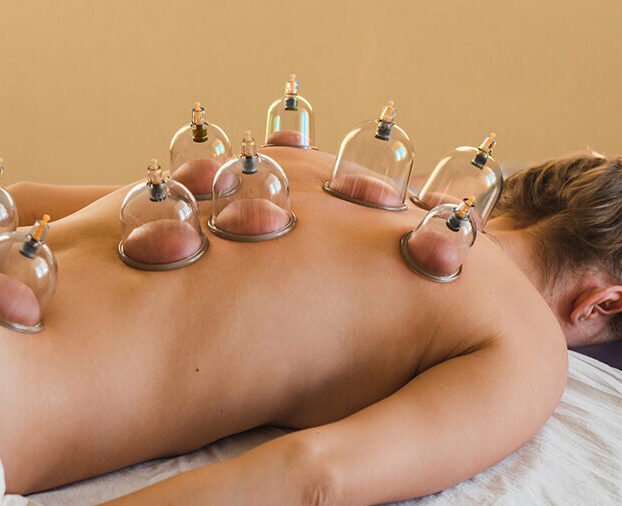CUPPING THERAPY

Cupping is a therapeutic technique performed by physiotherapist that involves using suction cups to create a vacuum on the skin.
This therapy has been used for centuries in traditional medicine and is now gaining popularity in modern physiotherapy practice. Physiotherapists may use cupping as part of a broader treatment plan to help patients.
Cupping therapy used by physiotherapist is believed to have various benefits, including reducing pain, inflammation, and muscle tension, as well as promoting relaxation and improving circulation. It is often used to treat conditions such as back pain, neck pain, headaches, reduce inflammation, and improve circulation.
WHAT CONDITIONS CAN BE TREATED WITH CUPPING THERAPY ?
Cupping therapy is believed to have potential benefits for a variety of conditions.Physiotherapy performs cupping on different reigons. Some of the conditions that cupping therapy is commonly used to treat include: Cupping therapy may help with the following conditions, among others:
Lower back pain
Neck and shoulder pain
Headache and migraine
Knee pain
Frozen shoulder
Facial paralysis
Cough and dyspnea
Acne
Lumbar disc herniation
Cervical spondylosis
Brachialgia, the pain produced by a trapped nerve in the neck
Carpal tunnel syndrome
Hypertension
Rheumatoid arthritis
Arthritis
Asthma
Cupping therapy is believed to have a number of potential benefits, some of the possible benefits of cupping therapy include:
- Pain relief: Cupping therapy is often used to help relieve muscle and joint pain, including back pain, neck pain, and headaches.
- Reduced inflammation: Cupping therapy may help to reduce inflammation by increasing blood flow and oxygen to the affected area.
- Improved circulation: The suction created by the cups can help to improve circulation, which can in turn promote healing and improve overall health.
- Relaxation: Many people find cupping therapy to be relaxing and stress-reducing, which can have a positive impact on both physical and mental health.
- Enhanced immune system function: Some proponents of cupping therapy believe that it can help to boost the immune system by stimulating the production of white blood cells.
- Improved skin health: Cupping therapy may help to improve the appearance and health of the skin by increasing blood flow and oxygen to the area.
Does cupping remove toxins?
According to the research mentioned above, cupping may remove toxins by stimulating the immune response, both locally and systemically.
It may also eliminate uric acid, a natural waste product from the digestion of certain foods. Uric acid build up can lead to high levels of acidity in the blood and urine.
Cupping used by physiotherapist may also have a positive effect on the lymphatic system, which is partially responsible for eliminating your body’s waste.
When the flow of lymph is interrupted, it can cause fluid buildup and prevent the body from properly eliminating toxins. Lymphatic drainage massage done by physiotherapist is one solution to this issue. Similarly, cupping may help increase the flow of lymph and prevent fluid buildup.
What are the different types of cupping?
Cupping was likely first performed using animal horns. Later, cups were made from bamboo and then ceramic.
Suction was primarily created through the use of heat. Cups were originally heated with fire and then applied to the skin. As they cooled, the cups drew the skin inside.
Modern cupping done by physiotherapist/Chiropractor is often performed using bell-shaped glass cups. They may also be made of plastic or silicone.
There are four main categories of cupping performed today:
Dry cupping: a suction-only method
Wet/bleeding cupping: may involve both suction and controlled medicinal bleeding
Dynamic cupping: also known as movement cupping, is a form of therapy that involves using suction cups to create a vacuum on the skin. Unlike traditional static cupping, where the cups are left in place, dynamic cupping involves moving the cups along the skin to create a massaging effect.
Flash cupping: involves quick, repeated suction and release of cups on an area of the body
Cups are most often applied to the:
back
chest
abdomen
buttocks
legs
Generally, the back is the most common area for cups to be used. If you’re receiving facial or cosmetic cupping, cups will be placed on your face.
How does the suction part work?
The cup is often heated with fire using alcohol, herbs, or paper that’s placed directly into the cup. The fire source is removed, and the heated cup is placed with the open side directly onto your skin.
When the hot cup is placed onto your skin, the air inside the cup cools and creates a vacuum that draws the skin and muscle up into the cup. Your skin may turn red as the blood vessels respond to the change in pressure.
Some modern cupping physiotherapist/Chiropractor have shifted to using rubber pumps to create suction versus more traditional heat methods.
How long will my session last?
With dry cupping, the cup is kept in place for a set time, usually between 5 and 10 minutes.
With wet/bleeding cupping, the physiotherapist makes a small incision to draw blood before intentionally pulling stagnant blood out of the incision with the suction of the cup.
Running cupping usually involves the application of oil before the use of suction. Then the cups are slowly moved around the area, creating a massage-like effect. Depending on the kind of service you’re receiving, your session could last anywhere from 10 minutes to an hour or more.
When it comes to flash cupping, the cups are quickly suctioned and then released, usually in the same generalized area of the body. This is usually a 5 to 10 minute process as well.
How long will it take for cupping marks to disappear?
Any discoloration or marks from cupping usually go away within 7 days of the session.
